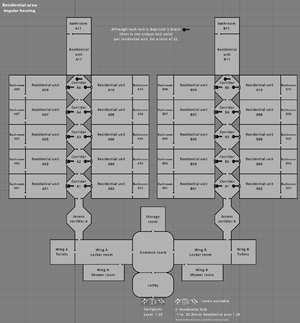Residential area
| Navigation: | Main Page → Civilized Areas → Facilities → Residential area | |||
A residential area is a facility providing housing. The layout of a typical residential area essentially forms a collection of 22 dorms, arranged in two wings of 11 units. A residential unit is composed of two rooms: a general-purpose bedroom/living space and a bathroom.
The total population of a town can be estimated by the number of residential areas it posseses, with very small towns possessing less than five, and very large towns having up to twenty. Although a residential unit needs only one resident to be active, they are most often occupied by several people at once, often creating a strong sense of community life, at the cost of privacy.
Becoming a resident of a particular residential area makes one an inhabitant of that town. Residential areas function on the basis of monthly renting; one flat fee per unit (and not per resident), encouraging people to live together in the same unit and split the costs. Rent costs vary wildly depending on the location, the faction in control, demand for a particular area or unit, and many other factors, ranging from a few hundred Parallars to several thousand. Because of the costs involved, it is considered a symbol of wealth and luxury to live in a residential unit alone or with less than two other people.
Residential areas have managers, which answer to the mayor. Their purpose is to collect rent, assign residents to units, manage problems and disputes, provide information and security at the lobby, and many more incidental duties. In a way, managers are community leaders of a sort, with more or less discretion and authority depending on the town and local customs. Managers receive payment in the form of free residency (units A01 or A11 are typically reserved for the manager) and financial compensation, scaled with the rent collected every month, incentivizing them to populate as many residential units as possible.
Map
Rooms
Access corridor
- Personnel: None
- Furniture: Posters, notes, announcement boards
- Cover:
- Side 2: Static tactical shield, Guardian (80 health, A3)
Bathroom
- Personnel: None, but often visited by the residents of the adjacent residential unit
- Furniture: Mirror, sink, 2 shower cabins, toilet seats
- Cover:
- All sides: None
Common room
- Personnel: None, but often visited by residents
- Furniture: Couch, widescreen TV, radio, tables, chairs, bookshelves
- Cover:
- Side 2: Couch (36 health, A1)
- Side 3: Table (36 health, A1)
- Side 4: Table (36 health, A1)
Corridor
- Personnel: None
- Furniture: Posters, notes, announcement boards
- Cover:
- All sides: None
Lobby
- Personnel: Citizen (Residential area manager)
- Furniture: Desk, chair, computer, file cabinets, announcement board, posters
- Cover:
- Side 2: Desk (36 health, A1)
- Side 3: File cabinet (57 health, A2)
- Side 4: File cabinet (57 health, A2)
Locker room
- Personnel: None, but often visited by residents
- Furniture: Walls of lockers (each one counts as a container with a mechanical lock), benches, announcement boards
- Cover:
- All sides: None
Residential unit
- Personnel: Varying amounts of citizens as residents
- Furniture: Bedding (see below), bookshelves, containers, radio, television, potted plants, framed pictures, posters
- Cover:
- All sides: None
The higher the density (number of residents) of a residential unit, the more likely the bedding will be compact and space efficient (single or small-single beds, bunk beds). Conversely, low-density residential units are more likely to have larger, more comfortable beds (doubles, queen-size, king-size)
Shower room
- Personnel: None, but often visited by residents
- Furniture: Mirror, sink, 12 shower cabins, temporary-use lockers
- Cover:
- All sides: None
The temporary-use lockers are generally empty and possess no locking mechanism. Their purpose is to temporarily stash clothing and equipment while taking a shower, protecting them from water and humidity.
Storage room
- Personnel: None, but occasionally visited by the residential area manager
- Furniture: Industrial shelves, storage boxes, dumpster
- Cover:
- All sides: Storage boxes (66 health, A3)
